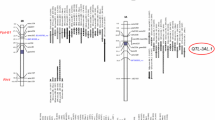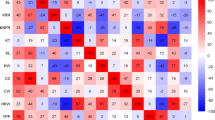Abstract
Quantitative trait loci (QTLs) for grain yield, dry matter content and test weight were identified in an F2 segregating population derived from a single cross between two elite maize lines (B73 and A7) and testcrossed to two genetically divergent in breds. Most of the QTLs inferred were consistent across locations, indicating that the expression of the genes influencing the traits under investigation was largely independent of the environment. By using two different tester lines we found that QTLs exhibited by one tester may not necessarily be detected with the second one. Only loci with larger effects were consistent across testers, suggesting that interaction with tester alleles may contribute to the identification of QTLs in a specific fashion. Analysis across both testers revealed four significant QTLs for grain yield that explained more than 35% of the phenotypic variation and showed an overall phenotypic effect of more than 2t/ha. The major QTL for grain yield, located in the proximity of the Nucleolus Organiser Region, accounted for 24.5% of the phenotypic variation for grain yield and showed an average effect of allele substitution of approximately 1 t/ha. Marker-assisted introgression of the superior A7 allele at this locus in the B73 genetic background will not differ from qualitative trait introgression and will eventually lead to new lines having superior testcross performance.
Similar content being viewed by others
References
Ajmone-Marsan P, Egidy G, Monfredini G, Di-Silvestro S, Motto M (1993) RAPD markers in maize genetic analysis. Maydica 38: 259–264
Beavis WD, Grant D, Albertsen M, Fincher R (1991) Quantitative trait loci for plant height in four maize populations and their association with qualitative genetic loci. Theor Appl Genet 83: 141–145
Burr B, Burr FA, Thompson KM, Albertson MC, Stuber CW (1988) Gene mapping with recombinant in breds in maize. Genetics 118: 519–526
Cluster PD, Marinkovic D, Allard RW, Ayala FJ (1987) Correlation between development rates, enzyme activities, ribosomal DNA spacer-length phenotypes, and adaptation in Drosophila melanogaster. Proc Natl Acad Sci USA 84:610–614
Coe EH, Hoisington DA, Neuffer MG (1990) Linkage map of corn (maize) (Zea mays L.). In: O'Brien SJ (ed) Genetic maps, 5th edn. Cold Spring Harbor Laboratory Press, Cold Spring Harbor, N.Y., pp 639–667
Cowen NM (1988) The use of replicated progenies in marker-based mapping of QTLs. Theor Appl Genet 75:857–862
Edwards MD, Stuber, CW, Wendel JF (1987) Molecular marker facilitated investigation of quantitative-trait loci in maize. I. Numbers, genomic distribution and type of gene actions. Genetics 116:113–125
Edwards MD, Helentjaris T, Wright S, Stuber CW (1992) Molecularmarker-facilitated investigations of quantitative trait loci in maize. IV. Analysis based on genome saturation with isozyme and restriction fragment length polymorphism markers. Theor Appl Genet 83:765–774
Falconer DS (1989) Introduction to quantitative genetics. Longman Scientific & Technical, London
Frankham R, Briscoe DA, Nurthen RK (1980) Unequal crossing over at the rDNA tandon as a source of quantitative genetic variation. Genetics 95:727–742
Gebhardt C, Salamini F (1992) Restriction fragment length polymorphism analysis of plant genomes and its application to plant breeding. Annu Rev Cytol 135:201–237
Haldane JBS (1919) The combination of linkage values and the calculation of distance between the loci of linked factors. J Genet 8:299–309
Hallauer AR, Miranda JB (1988) Quantitative genetics in maize breeding, 2nd edn. Iowa State University Press, Ames, Iowa
Helentjaris T (1987) A genetic linkage map for maize based on RFLPs. Trends Genet 3:217–221
Hull FH (1947) Cryptic homozygous lines. J Am Soc Agron 39: 438–439
Keim P, Diers BW, Olson TC, Shoemaker RC (1990) RFLP mapping in soybean: association between marker loci and variation in quantitative traits. Genetics 126:735–742
Knapp SJ, Stroup WW, Ross WM (1985) Exact confidence intervals for heritability on a progeny mean basis. Crop Sci 25:192–194
Lander ES, Botstein D (1989) Mapping Mendelian factors underlying quantitative traits using RFLP linkage maps. Genetics 121:185–199
Lander ES, Green P, Abrahamson J, Barlow A, Daly MJ, Lincoln SE, Newburn L (1987) MAPMAKER: an interactive computer package for constructing primary genetic linkage maps of experimental and natural populations. Genomics 1:174–181
Landry BS, Kessell R, Farrara B, Michelmore RW (1987) A genetic map of lettuce (Lactuca sativa L.) with restriction fragment length polymorphism, isozyme, desease resistance and morphological markers. Genetics 116:331–337
Lincoln SE, Lander ES (1990) Mapping genes controlling quantitative traits with MAPMAKER/QTL. Whitehead Institute for Biomedical Research Technical Report, Cambridge, Mass.
Livini C, Ajmone-Marsan P, Melchinger AE, Messmer MM, Motto M (1992) Genetic diversity of maize inbred lines within and among heterotic groups revealed by RFLP. Theor Appl Genet 84:17–25
Mather K (1941) Variation and selection of polygenic characters. J Genet 41:159–193
Melchinger AE, Messmer MM, Lee M, Woodman WL, Lamkey KR (1991) Diversity and relationships among U.S. maize inbreds revealed by restriction fragment length polymorphisms. Crop Sci 31:669–678
Mode CJ, Robinson HF (1959) Pleiotropism and the genetic variance and covariance. Biometrics 15:518–537
Nienhuis J, Helentjaris T, Slocum M, Ruggero B, Schaefer A (1987) Restriction fragment length polymorphism analysis of loci associated with insect resistance in tomato. Crop Sci 27:797–803
Paterson AH, Tanksley SD, Sorrels ME (1988a) DNA markers in plant improvement. Adv Agron 46:39–90
Paterson AH, Lander ES, Hewitt JD, Peterson S, Lincoln SE, Tanksley SD (1988b) Resolution of quantitative traits in Mendelian factors by using a complete linkage map of restriction fragment length polymorphisms. Nature 335:721–726
Paterson AH, Damon S, Hewitt JD, Zamir D, Rabinowitch HD, Lincoln SE, Lander ES, Tanksley SD (1991) Mendelian factors underlying quantitative traits in tomato: comparison across species, generations and environments. Genetics 127:181–197
Reiter RS, Coors, JC, Sussman MR, Gabelman WM (1991) Genetic analysis of tolerance to low-phosphorus stress in maize using restriction fragment length polymorphisms. Theor Appl Genet 82:561–568
Rocheford TR, Osterman JC, Gardner CO (1990) Variation in the ribosomal intergenic spacer of a maize population mass-selected for high grain yield. Theor Appl Genet 79:793–800
Sax K (1923) The association of size differences with seed coat pattern and pigmentation in Phaseolus vulgaris. Genetics 8:552–560
Schön CC, Lee M, Melchinger AE (1993) Mapping and characterisation of quantitative trait loci affecting resistance against Second-Generation Corn Borer in maize with the aid of RFLPs. Heredity 70:648–659
Schön CC, Melchinger AE, Boppenmaier J, Brunklaus-Jung E, Herrmann RG, Seitzer JF (1994) RFLP mapping in maize: Quantitative trait loci affecting testcross performance of elite European flint lines. Crop Sci 34:378–389
Searle SR (1971) Linear Models. Wiley, New York
Shapiro SS, Wilk MB (1965) An analysis of variance test for normality (complete samples). Biometrika 52:591–611
Smith OS, Smith JSC, Bowen SL, Temborg RA, Wall SJ (1990) Similarities among a group of elite maize inbreds as measured by pedigree, F1 grain yield, heterosis and RFLPs. Theor Appl Genet 80:833–840
Snape JW, Law CN, Worland AJ (1977) Whole chromosome analysis of height in wheat. Heredity 38:25–36
Stuber CW (1992) Biochemical and molecular markers in plant breeding. Plant Breed Rev. 9:37–61
Stuber CW, Lincoln SE, Wolff DW, Helentjaris T, Lander ES (1992) Identification of genetic factors contributing to heterosis in a hybrid from two elite maize inbred lines using molecular markers. Genetics 132:823–839
Thompson JN Jr, Thoday JM (1974) A definition and standard nomenclature for “polygenic loci”. Heredity 33:430–437
Walton M, Helentjaris T (1987) Application of restriction fragment length polymorphism (RFLP) technology to maize breeding. In: 42nd Annu Corn Sorghum Res Conf. American Seed Trade Assoc, Washington, D.C., pp 48–75
Weir BS (1990) Genetic data analysis. Sinauer, Sunderland, Mass.
Author information
Authors and Affiliations
Additional information
Communicated by F. Salamini
Rights and permissions
About this article
Cite this article
Ajnone-Marsan, P., Monfredini, G., Ludwig, W.F. et al. In an elite cross of maize a major quantitative trait locus controls one-fourth of the genetic variation for grain yield. Theoret. Appl. Genetics 90, 415–424 (1995). https://doi.org/10.1007/BF00221984
Received:
Accepted:
Issue Date:
DOI: https://doi.org/10.1007/BF00221984




